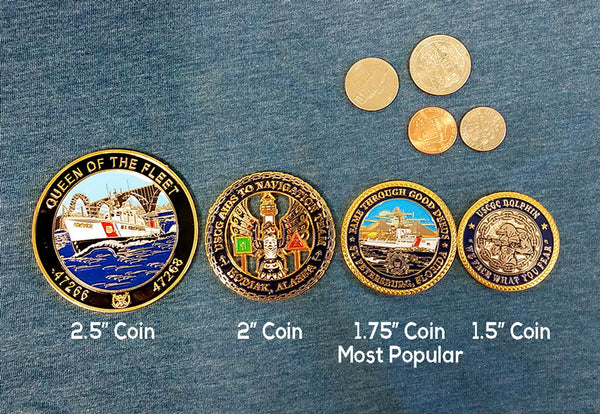How to Choose the Right Coin Size for Your Custom Design
When it comes to custom challenge coins, one of the most common questions clients face is: What size should I choose? The right coin size impacts the design clarity, overall look, and how well it aligns with your design vision. This blog aims to simplify the selection process by breaking down the most common coin sizes, how to optimize design elements, and practical tips for finding the best fit based on your needs.

Common Coin Sizes: The Go-To Starting Point
For most people, the easiest way to begin is by looking at the most popular coin sizes: 1.5 inches, 2 inches, and 2.5 inches. These sizes offer a balance between visibility, design detail, and general versatility.
- 1.5 inches: This compact size is great for simple designs with minimal text or small logos. It’s often used for everyday coins or when a discreet token is desired.
- 2 inches: This is the standard size for most challenge coins, offering enough space for detailed designs while maintaining a comfortable, hand-held feel. It’s a versatile choice, suitable for both corporate events and military coins.
- 2.5 inches: Perfect for those looking to highlight intricate designs or include longer text. This larger size allows for better detail and clarity, making it an ideal option for commemorative or award coins.

Starting with these sizes can give you a solid baseline. If one of these options fits your design needs, you’re off to a good start. However, if the design doesn’t fully meet your expectations, it’s time to consider more detailed adjustments.
Adjusting Design Elements: Optimizing Text and Images
If the initial choice of coin size doesn’t fully meet your design expectations, there are two common issues to address: the size of the text and the clarity of the images. Here’s how to refine the design elements to maximize their impact within the chosen coin size:
- Text Adjustment: Ideally, text should occupy around 30-40% of the coin’s surface area. For a 1.5-inch coin, this equates to around 20 characters, while a 2-inch coin can comfortably hold up to 40 characters. If the text appears too cramped, consider reducing the font size or using fewer words to improve readability.
- Image Scaling: Images or logos should typically occupy around 50-60% of the coin’s surface. On a 2-inch coin, this allows for a medium-sized logo to appear clear and detailed. If your design includes complex graphics, you might need to scale down less important details or opt for a larger coin size to maintain the design’s integrity.
By making these adjustments, you might find that the standard size coin can still meet your design requirements. However, if the design still doesn’t look right, it may be time to consider increasing the coin size.

Choosing the Right Size Based on Design Details
If scaling the design elements still doesn’t achieve the desired result, it’s time to focus on the design itself and reverse-engineer the ideal coin size. This approach ensures that all the critical details of your design are preserved.
- Complex Graphics: If your design features intricate patterns or detailed illustrations, a 2.5-inch coin might be necessary to ensure clarity. Larger coins offer more space, preventing details from getting lost or appearing too crowded.
- Extended Text: For designs that feature longer phrases, slogans, or detailed descriptions, increasing the coin size to 2.5 inches or more will allow for better readability and overall balance.
This reverse-engineering approach ensures that the final product aligns with your vision, preserving both the aesthetics and clarity of the design.
Balancing Size with Budget
While choosing the right size is essential, it’s equally important to consider the budget. Here’s a quick breakdown of how different coin sizes and design choices can impact costs:
- Basic Coin Prices:
- 1.5-inch coin: Ranges from $2.50 to $3.00 per piece.
- 2-inch coin: Ranges from $3.00 to $4.00 per piece.
- 2.5-inch coin: Ranges from $4.00 to $5.50 per piece.
- Special Effects: Adding features like glow-in-the-dark finishes, glitter, or dual plating can increase the cost by $0.50 to $1.00 per coin, depending on the effect and design complexity.
- Quantity Discounts: The more coins you order, the lower the per-unit cost. For example, ordering 100 coins vs. 300 coins can reduce the price by up to 15-20%.
- Material Options: Choosing standard materials like zinc alloy or brass is generally more cost-effective, while more durable options like stainless steel may increase the price by $0.30 to $0.50 per coin.
By understanding these factors, you can make more informed decisions that balance design needs and budget constraints.
Why Choose Blythepin for Your Custom Coins?
At Blythepin, we understand the complexities of choosing the right coin size. With over 20 years of experience, our team is here to guide you through every step, from design adjustments to final production. Our high-quality craftsmanship, special effects (such as glow-in-the-dark or iridescent finishes), and flexible production options ensure that your vision comes to life perfectly.
Ready to start creating your custom coin? Contact us today for a free consultation and personalized quote!

Comments